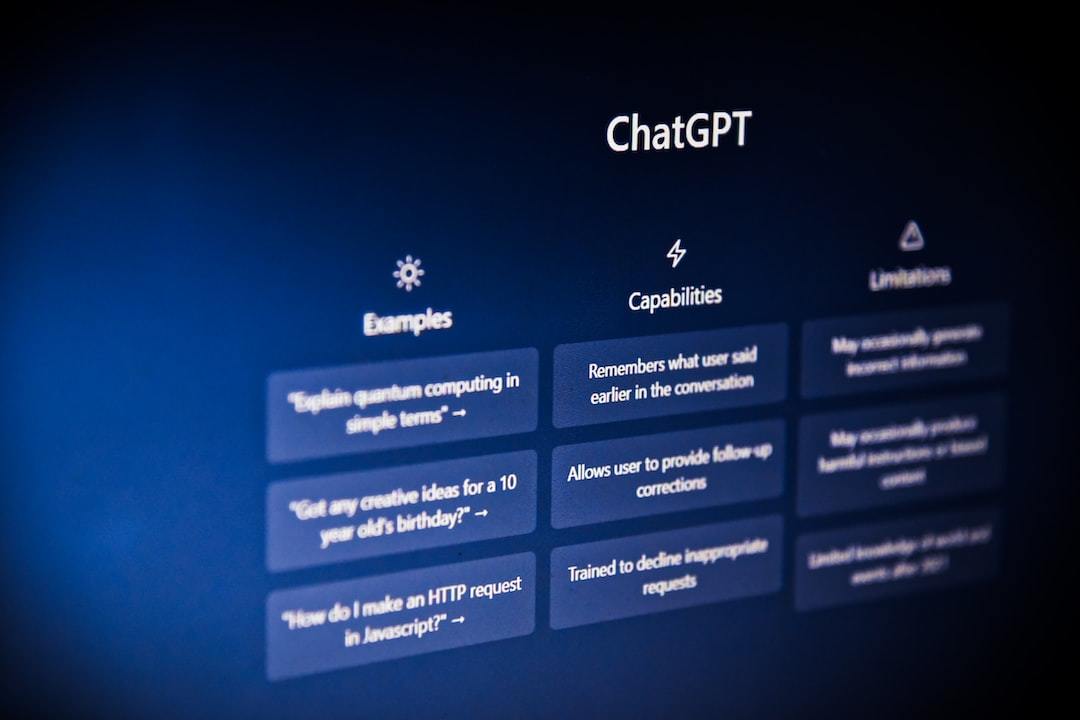
Chatbots have become an integral part of the digital marketing landscape, and has revolutionized how businesses engage with their customers. AI’s progression has enabled chatbot tech to rapidly progress, allowing marketers to better the user experience and streamline processes.
In this comprehensive overview, we will investigate the captivating domain of AI chatbots and explore their historical background as well as modern advancements in conversational agents. We’ll examine different types of chatbots – declarative and predictive – while highlighting key features that set them apart.
Moreover, we will discuss various applications across industries where these intelligent bots are making significant strides in customer service automation and lead generation strategies. The cost-effectiveness and scalability benefits offered by automated solutions open up exciting possibilities for operational savings and geographic expansion through technology.
As we navigate the ethical considerations surrounding AI development, it’s crucial to understand responsible algorithm creation practices while being aware of potential consequences associated with blind trust on AIs. Finally, our journey concludes with a look at the future role of chatbots in digital marketing as major tech companies vie for dominance in this rapidly growing industry.
Table of Contents:
- Evolution of Chatbots
- Early Chatbot Pioneers and Breakthroughs
- The Emergence of AI-Driven Conversational Agents
- Types of Chatbots
- Applications Across Industries
- Cost-effectiveness and Scalability
- Ethical Considerations in AI Development
- Future of Chatbots in Digital Marketing
- FAQs in Relation to Chatbots
- Conclusion
Evolution of Chatbots
The history and development of chatbots has come a long way since their inception in 1966 by Joseph Weizenbaum. Chatbots have advanced significantly since their introduction, from basic rule-based systems to more sophisticated AI-powered ones like ChatGPT which incorporate technologies such as AI, ML, NLU and NLP.
Early Chatbot Pioneers and Breakthroughs
In 1966, Joseph Weizenbaum created ELIZA, one of the first-ever chatbot programs that mimicked human conversation using pattern matching techniques. Later on, in 1995, Richard Wallace developed ALICE (Artificial Linguistic Internet Computer Entity) based on AIML (Artificial Intelligence Markup Language) which allowed developers to create more sophisticated user experiences.
The Emergence of AI-Driven Conversational Agents
As technology progressed over time, AI-driven conversational agents started emerging with improved capabilities for handling complex conversations. In recent years, companies like Google introduced Dialogflow, an NLU platform that enables businesses to build intelligent virtual assistants capable of understanding users’ intents and providing personalized responses.
- AI Chatbots: These bots use artificial intelligence algorithms to understand context better than traditional rule-based systems.
- Natural Language Processing: This technique helps parse text input into structured data, allowing chatbots to understand user queries and respond accordingly.
- Machine Learning: ML algorithms help chatbot technology learn from past interactions, improving their responses over time.
The advent of chatbots has enabled businesses to interact with customers in a more efficient and personalized manner. Today’s AI-powered bots can handle complex conversations while providing personalized information based on individual preferences. This advancement in technology is revolutionizing the way we communicate and engage with brands online.
The advancement of chatbot technology has brought us to a point where we can now utilize AI-powered conversational agents for automated customer service. To make an informed decision on which chatbot is best suited for your needs, it is essential to be aware of the various types of AI-driven conversational agents available.
Types of Chatbots
Declarative and predictive chatbots are two main types of technology used in digital marketing to provide quick, personalized responses that enhance customer engagement. Both types have unique features and capabilities that cater to different user experiences, but they all aim to enhance customer engagement by providing quick and personalized responses.
Declarative Chatbots Explained
Declarative chatbots, also known as rule-based or scripted bots, rely on a predetermined set of rules for their interactions with users. These rules dictate how the bot should respond based on specific keywords or phrases inputted by the user. While these chatbots can be efficient in handling simple queries, they may struggle when faced with more complex inquiries due to their limited flexibility.
Predictive Chatbot Features
On the other hand, predictive chatbots leverage artificial intelligence (AI), machine learning (ML), natural language understanding (NLU), and natural language processing (NLP) technologies to understand context and generate appropriate responses. Unlike declarative bots, predictive ones can learn from previous interactions and adapt accordingly over time. This ability allows them to provide more accurate answers while also offering personalized information based on individual preferences.
- Data-driven training: Predictive AI chatbots use data gathered from past conversations with users as well as external sources like social media profiles or CRM systems to improve their performance continuously.
- Natural Language Understanding: NLU algorithms enable these bots not only to recognize text inputs but also to interpret emotions, intents, and sentiments behind them.
- Personalization: By collecting personal information such as browsing history or purchase preferences, predictive chatbots can tailor their responses to each user’s unique needs and interests.
In summary, both declarative and predictive chatbots play crucial roles in enhancing customer engagement within digital marketing strategies. While the former offers a more structured approach for simple interactions, the latter utilizes advanced AI technologies to deliver highly personalized experiences that cater to users’ specific requirements.
Chatbots are a powerful tool for digital marketers to increase customer engagement and automate certain tasks. By understanding the various types of chatbot available, businesses can begin to explore how they can apply them across different industries.
Chatbots in digital marketing come in two main types: declarative and predictive. Declarative chatbots rely on predetermined rules for interactions, while predictive chatbots use AI technologies to understand context and personalize responses based on user preferences. Predictive bots can continuously improve through data-driven training, NLU algorithms, and personalization features.
Applications Across Industries
Chatbot technology has made significant strides in recent years, with AI chatbots now being used across various industries to enhance user experiences and streamline operations. Let’s explore some of the key sectors where chatbot applications are transforming customer engagement.
Customer Service Improvements Through Automation
In the realm of customer support, AI-powered chatbots have become indispensable tools for businesses looking to automate routine tasks and provide instant assistance. These intelligent conversational agents can handle a wide range of queries, from troubleshooting issues to providing product information. As a result, customers enjoy faster response times while companies benefit from reduced operational costs and improved efficiency. For example, Gartner predicts that by 2023, AI-enabled automation will recover 25% of end-user service desk contact volume.
Lead Generation Strategies Powered by Bots
- Sales & Marketing: Chatbots play an essential role in modern sales and marketing efforts by engaging potential customers through personalized interactions based on their personal information and preferences. This targeted approach helps increase conversion rates while reducing manual labor required for lead nurturing.
- Educational Enhancement: In the education sector, artificial intelligence-driven bots help students access learning resources more efficiently or receive immediate feedback on assignments or quizzes without waiting for human intervention.
- Troubleshooting IT Issues: A great example is ASOS’s Enki bot which assists users with common IT problems like password resets or software installations.
The versatility of chatbot applications is evident in their growing adoption across industries. As businesses continue to leverage this technology, we can expect even more innovative use cases and enhanced customer engagement strategies.
Chatbots can be a valuable asset for firms in multiple sectors, aiding customer support, creating leads and optimizing efficiency. With cost-effectiveness and scalability in mind, Sentic can help you take advantage of automated solutions to expand your business geographically.
Cost-effectiveness and Scalability
The implementation of AI chatbots in digital marketing strategies offers numerous advantages, particularly when it comes to cost-effectiveness and scalability. By automating various aspects of customer engagement, businesses can significantly reduce operational costs while simultaneously expanding their reach into new markets.
Operational Savings Provided by Automated Solutions
Incorporating chatbot technology into a company’s digital marketing efforts allows for the efficient handling of repetitive tasks such as answering frequently asked questions or guiding users through specific processes. This automation frees up valuable time for employees to focus on more complex issues that require human intervention. Employees can be freed up to focus on more complex tasks, leading to savings in labor costs without compromising the quality of user experiences.
- IBM Watson reports that businesses using AI chatbots have seen reductions in support costs by up to 30%.
- A study conducted by Juniper Research predicts that AI-driven customer service interactions will save businesses $8 billion annually by 2023.
Geographic Expansion Opportunities Enabled via Technology
Beyond cost savings, another key advantage offered by artificial intelligence is its ability to facilitate geographic expansion for businesses. Chatbots are capable of managing incoming calls from different locations seamlessly across multiple languages and time zones. This enables organizations to broaden their market presence with minimal additional resources or effort required.
In conclusion, the implementation of AI chatbots in digital marketing strategies can provide significant cost savings and scalability opportunities for businesses. Additionally, chatbot technology can facilitate geographic expansion and improve user experiences without sacrificing quality. It is important to note that businesses must prioritize the protection of personal information when utilizing chatbots to ensure the trust and loyalty of their customers.
The cost-effectiveness and scalability of automated solutions provide a range of operational savings, allowing businesses to expand their geographic reach with relative ease. Moving forward, it is important to consider the ethical implications associated with developing responsible algorithms as blind trust in AI technology can have unintended consequences.
Ethical Considerations in AI Development
Given the rapid development of chatbot technology and AI, ethical considerations must be addressed to ensure responsible innovation and protect users’ rights. Addressing potential risks posed by advancements in this domain, such as misinformation, miscommunication, and intolerance towards users’ rights within certain domains is crucial for responsible innovation.
Ethics behind developing responsible algorithms
In order to create ethically sound AI chatbots, developers must prioritize transparency and accountability throughout the design process. This includes being open about how user data is collected and utilized while ensuring that personal information remains secure at all times. Additionally, it’s essential to develop fair algorithms that avoid bias or discrimination against any group of users based on factors like race, gender, or age.
Potential consequences associated with blind trust on AIs
Relying solely on AI-driven solutions without proper oversight can lead to unintended negative outcomes. For instance, a poorly designed algorithm might inadvertently promote fake news or harmful content due to its inability to differentiate between reliable sources and misleading ones. Moreover, blind trust in AI systems could result in a loss of human empathy when dealing with sensitive issues like mental health support through automated platforms.
- Action Item: Developers need to work closely with ethicists and other stakeholders during the design phase of chatbot technology projects.
- Action Item: Businesses implementing these technologies should establish clear guidelines for monitoring performance metrics related to ethical concerns regularly.
- Action Item: Users interacting with AI chatbots should be aware of the limitations and potential risks associated with these technologies, exercising caution when sharing personal information or relying on automated advice.
By addressing ethical considerations in AI development proactively, businesses can ensure that their chatbot solutions provide valuable user experiences while minimizing potential harm. As a result, they’ll be better equipped to foster trust among customers and maintain a positive brand reputation in today’s increasingly digital landscape.
It is critical to bear in mind ethical concerns when formulating AI algorithms, as this will be a determining factor of the eventual direction taken by chatbots in digital marketing. Moving forward, it is important to understand how major tech companies are leveraging advanced technologies and reshaping customer engagement strategies with their AI chatbot solutions.
Developers of AI chatbots must prioritize transparency, accountability, and fairness to create ethically sound algorithms that avoid bias or discrimination. Blind trust in AI systems can lead to unintended negative outcomes such as promoting fake news or a loss of human empathy when dealing with sensitive issues like mental health support through automated platforms. To address ethical considerations proactively, developers should work closely with ethicists and stakeholders during the design phase while businesses implementing these technologies establish clear guidelines for monitoring performance metrics related to ethical concerns regularly.
Future of Chatbots in Digital Marketing
As technology advances, chatbots are becoming increasingly important for businesses to engage with customers on digital platforms. With over 2.8 billion users sending more than 100 billion messages daily through platforms like WhatsApp and Facebook, AI-powered chatbots have proven invaluable resources for businesses trying to connect with customers on-the-go.
Major Tech Companies Vying for Dominance in AI Chatbot Industry
The competition among tech titans like Google, Amazon, Microsoft and IBM to take the lead in the AI chatbot sector has caused a surge of development in chatbot technology. These innovations are not only enhancing user experiences but also providing new opportunities for marketers seeking personalized ways of engaging their audience. As a result, businesses can now offer seamless customer support and gather valuable personal information that helps them better understand their clients’ needs.
Reshaping Customer Engagement Strategies Using Advanced Technologies
- Natural Language Processing (NLP): This advanced technology enables chatbots to comprehend complex language patterns used by humans during conversations. By leveraging NLP capabilities, businesses can create more meaningful interactions with customers while addressing their concerns effectively.
- Data Analysis: Incorporating artificial intelligence into customer engagement strategies allows marketers access to vast amounts of data generated from user interactions with chatbots. This information can be analyzed further using machine learning algorithms which help identify trends or preferences among consumers – enabling targeted marketing campaigns based on these insights.
- Omnichannel Integration: As chatbots become more sophisticated, they can be integrated across various channels like websites, social media platforms, and messaging apps. This seamless integration ensures that businesses maintain consistent communication with their customers regardless of the platform being used.
In the coming years, AI chatbots are poised to revolutionize digital marketing by offering personalized experiences tailored to individual customer preferences. By staying ahead of these technological advancements and embracing innovative solutions such as Sentic’s AI-driven services, marketers can ensure their brands remain competitive in an ever-evolving landscape.
The use of chatbots in digital marketing is expected to grow significantly as technology advances. Major tech companies are competing for dominance in the AI chatbot industry, leading to rapid advancements that enhance user experiences and provide new opportunities for marketers seeking personalized ways of engaging their audience. By leveraging advanced technologies such as natural language processing, data analysis, and omnichannel integration, businesses can reshape customer engagement strategies and offer personalized experiences tailored to individual customer preferences.
FAQs in Relation to Chatbots
What are the 4 types of chatbots?
The four main types of chatbots include: 1. Rule-based or scripted bots, which follow predefined rules and decision trees; 2. Retrieval-based bots, which use a database to provide answers based on user input; 3. Generative bots, powered by natural language processing (NLP) algorithms that generate responses in real-time; and 4. Context-aware, AI-driven conversational agents capable of understanding context and maintaining conversation flow.
What is the biggest problem with chatbots?
The most significant challenge for chatbot development is achieving a high level of accuracy in interpreting human language. This involves overcoming issues such as ambiguity, colloquialisms, typos, and complex sentence structures. Additionally, creating engaging conversations, managing user expectations effectively, and ensuring data privacy are other challenges faced by developers.
What are the negatives of chatbots?
Some drawbacks associated with using chatbots include potential miscommunication due to limited understanding capabilities, limitations in handling complex queries, risks related to misinformation dissemination when not properly monitored or updated regularly, and potential loss of human touch in customer interactions, which may affect user satisfaction.
Do chatbots really help?
Yes, chatbots can provide significant benefits when implemented effectively. They offer 24/7 availability for customer support, reduce operational costs, enhance user experience through personalized recommendations, assist with data collection and analysis for businesses to make informed decisions, and enable scalability by handling multiple queries simultaneously.
Conclusion
Chatbots have advanced significantly since their beginnings, and the rise of AI-driven conversational bots has provided businesses in many industries with novel opportunities. Declarative chatbots using scripted responses and predictive chatbots leveraging NLU algorithms are just two examples of the types of chatbots available to digital marketers today.
Chatbot technology is gaining traction as it offers cost-efficiency and scalability, with major tech companies investing in the space. However, ethical considerations must be taken into account when developing AI-powered bots to ensure responsible growth.
If you’re looking to implement chatbot technology into your business strategy or want to learn more about how it can benefit your organization’s customer service efforts, visit Sentic for more information.




